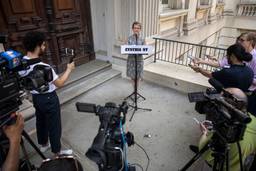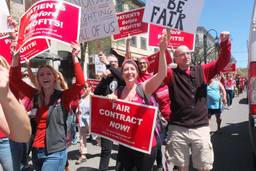
In 1992, media reports claimed that then-president George H.W. Bush was “amazed” at the sight of a grocery store scanner. While the claim has since been debunked, the encounter says a lot about his presidency.
Bush Sr., who died last week at the age of 94, appeared suspiciously wide-eyed about grocery scanner technology during a photo-op at a grocer convention. The episode was used as evidence during Bush’s re-election bid that he hadn’t been grocery shopping since the 1970s when scanners were first introduced.
Later revealed to have been the product of a creative misreading by the New York Times’ Andrew Rosenthal (who hadn’t been present at the convention), the farce — and the fact that so many at the time bought it — nonetheless reveals a deeper truth about his presidency: Bush Sr. was out of touch with the plight of working and middle-class Americans.
Bush was one of just five presidents in the 20th century to lose a re-election campaign. In 1994, he lost to Bill Clinton, the upstart governor from Arkansas, in the midst of a recession that swept the nation during the early 1990s. Bush had failed to recognize the simple truism of Clinton’s campaign: “It’s the economy, stupid.”
But setting aside his relative inaction during the recession, Bush’s long record of supporting policies that benefit the wealthy at the expense of average Americans cemented his legacy. He was no patrician statesman whose example can lead us out of our current dark times. Rather, he was a foot soldier for the ruling class who played a substantial role in bringing us to where we are today. His role as a chief architect of U.S. neoliberal trade policy through ushering in the North American Free Trade Agreement (NAFTA) helped to exacerbate global inequality and fuel the loss of over one million manufacturing jobs in the United States and Canada.
The epitome of privilege, the elder Bush descended from a lineage of businessmen who made their fortunes in the defense and banking industries. His father, Prescott Bush, was director of Union Banking Corporation, which financed and profited from the Nazi regime prior to the American entry into World War Two. George H.W., for his part, struck it rich in the Texas oil fields before turning to politics.
From the beginning of his presidency, Bush built on the legislative victories of the Reagan Revolution, spearheading wealth redistribution programs benefiting the corporate class — and his own family. In 1989, Bush bailed out the heavily deregulated Savings and Loan industry, to the tune of about $124.6 billion in taxpayer funded money. The New York Times later published a report detailing how Bush’s son Jeb had personally benefited from the bailout, noting that the federal government paid “more than $4 million to make good” on a loan Jeb had used to buy a Miami office building.
Bush appointed conservative judge Clarence Thomas to the Supreme Court, despite overwhelming evidence that he had sexually harassed his staffer Anita Hill. Thomas already had a long record as an enemy of working people of color. As chairman of the Equal Employment Opportunity Commission, Thomas played a key role in the agency’s shift away from class action cases that had sought compensation for large numbers of people and toward a narrower focus on individual cases that addressed highly specific acts of discrimination. As the Women’s Legal Defense Fund observed at the time: “the number of cases filed on behalf of individual claimants increased under Judge Thomas, but at the expense of class action litigation that can potentially compensate hundreds and even thousands of individual victims per suit.”
Thomas was a fierce critic of affirmative action, stating in 1987 that he believed such programs “create a narcotic of dependency.” On the bench, Thomas has proved to be a dependable ally of business and a foe of workers, and has helped cement the conservative majority responsible for a full frontal assault on labor, including the recent Janus ruling that will deal a substantial financial blow to public sector unions.
Bush also fought against raising the minimum wage. In 1989, he vetoed a bill raising the minimum wage to $4.55 an hour. His own version of the Fair Labor Standards Amendments which he signed into law that year, raised the minimum to $4.25, significantly lower than the original legislation.
Bush’s greatest assault on labor rights came with the passage of NAFTA, which he spearheaded and signed just a month before he left office. The trade deal faced widespread resistance from progressives and labor unions, but Bush’s commitment to neoliberal trade policy was unbending. In the Latin American Perspectives essay “NAFTA and the Corporate Redesign of North America,” Kim Moody explains that the “Bush administration, backed by a number of authoritative think tanks and business organizations, attempted to mute opposition to NAFTA by producing an expert consensus that the agreement was a win-win solution.”
According to Moody, the pro-NAFTA studies from think tanks like the Brookings Institution, the International Trade Commission (ITC) and the Heritage Foundation used an incredibly flawed econometric model that assumed conditions like full employment and no shifts of investment from one country to another. As originally reported in the United Auto Workers’ Washington Report and cited by Moody, the ITC even went so far as to provide fake numbers on auto job loss.
In Mexico, NAFTA coincided with structural adjustment programs and massive cuts to social welfare, resulting in the privatization of state industry, displacement of farmers, rise of consumer food prices and expansion of low-paid work. In the United States, NAFTA and other “free trade” apparatuses like the World Trade Organization contributed to privatization and the decline of environmental protections, jobs, wages, and workers’ rights. Along with offshoring one million manufacturing jobs from the United States and Canada to Mexico, NAFTA bolstered transnational capital by limiting regulations and opening new markets to private investment, helping to enshrine corporate power.
President Trump’s path to the White House rests in part on the working-class misery engendered by decades of neoliberal trade policies. During the 2016 campaign, Trump ran on an anti-free trade platform. Rather than proposing the dissolution of the entire existing trade system, Trump told voters he’d use his expert negotiating skills to secure a “better deal” for them. He cast the blame for inequality not on the greed of capital, but on “illegals” desperate and eager to take away jobs away from Americans.
While Trump’s rhetoric is appallingly racist and his policies have only benefited the rich, his ascent — along with the rise of far right populism in Europe — helps illustrates the extent of the damage dealt by Bush and other architects of neoliberal trade policy.
Many pundits are attempting to divorce Bush H.W. Bush from Trump and use the late president’s memory to invoke a kinder, gentler era of politics. But Bush Sr. bears plenty of responsibility for the uncivil world we live in today, and for the indignities visited on the working class across the globe.







